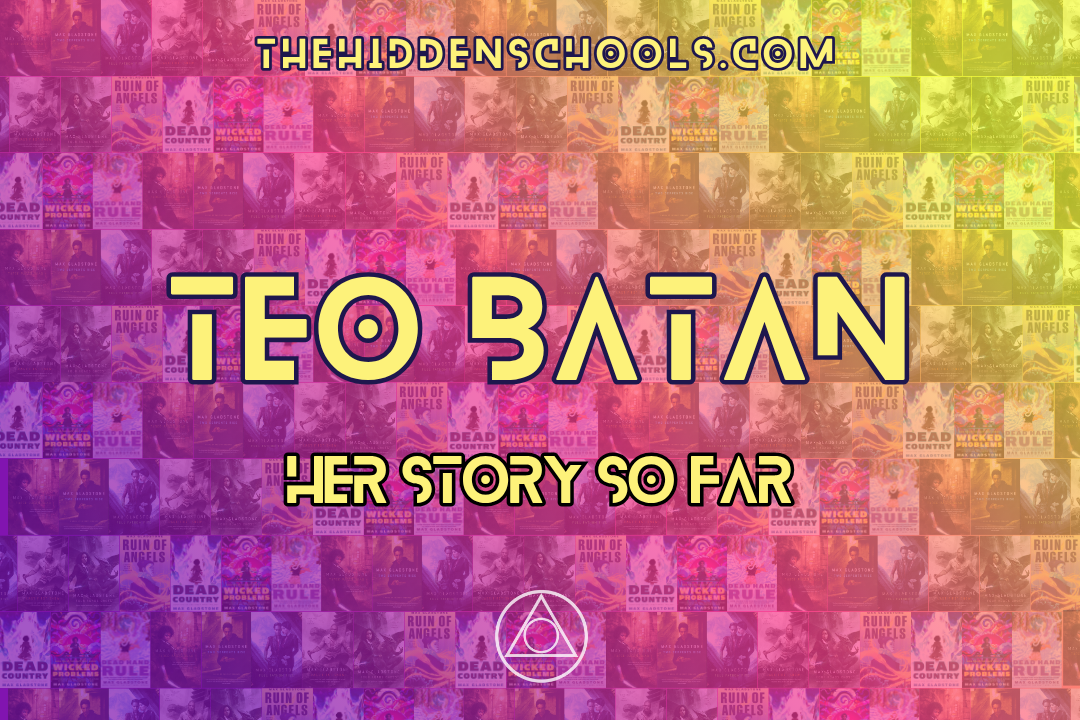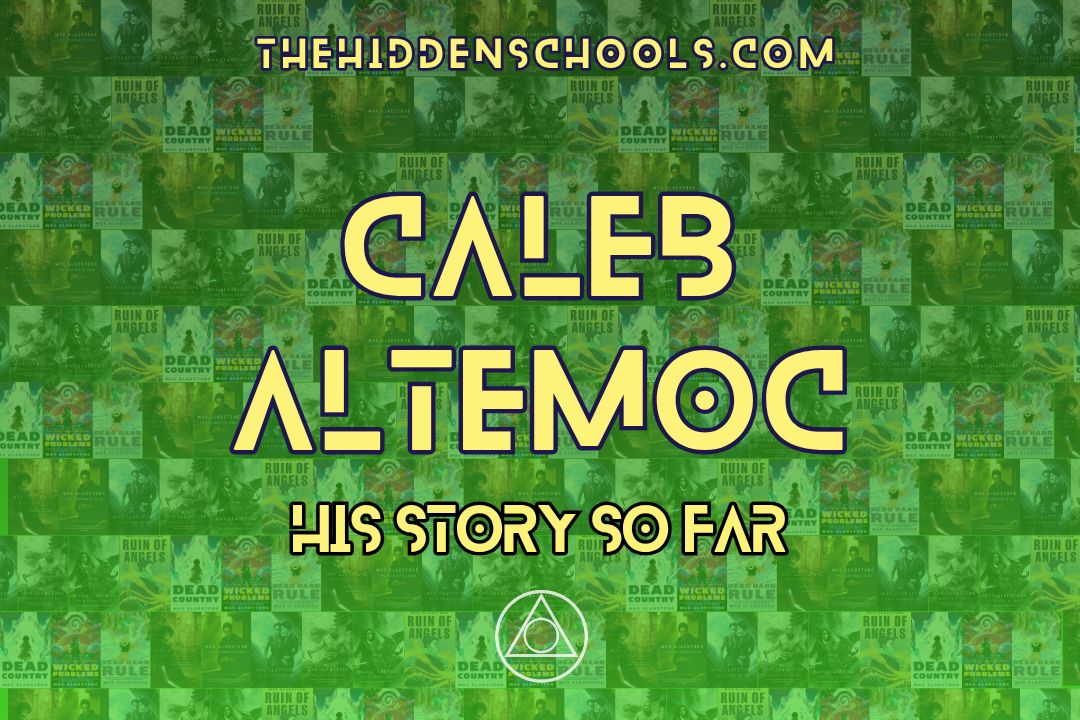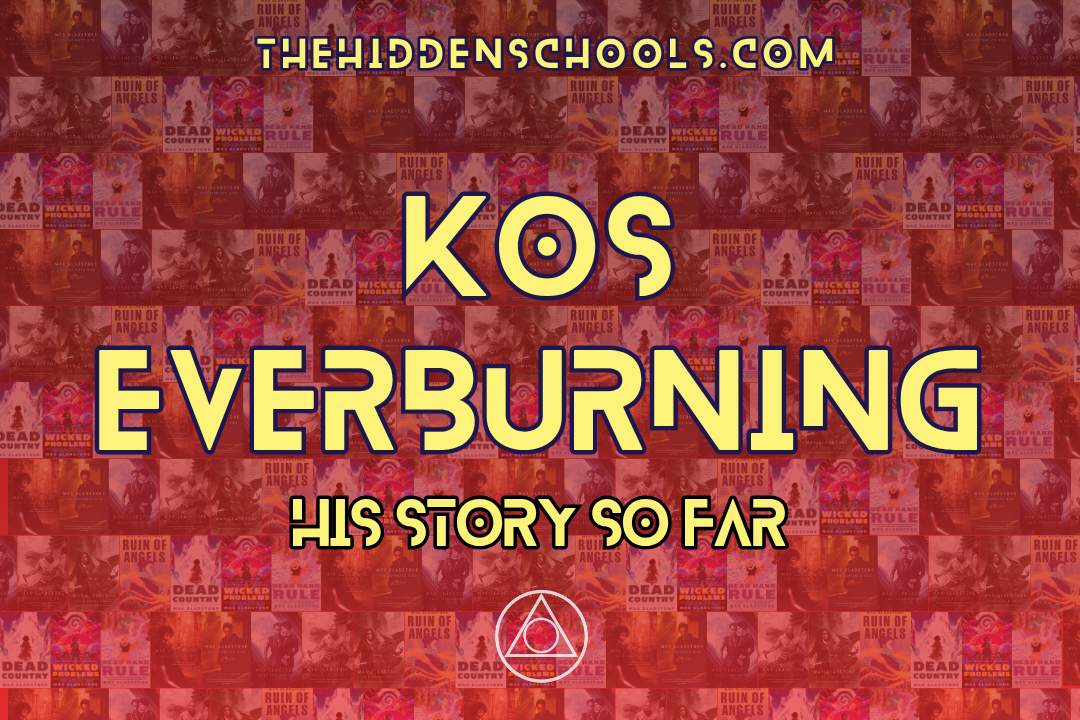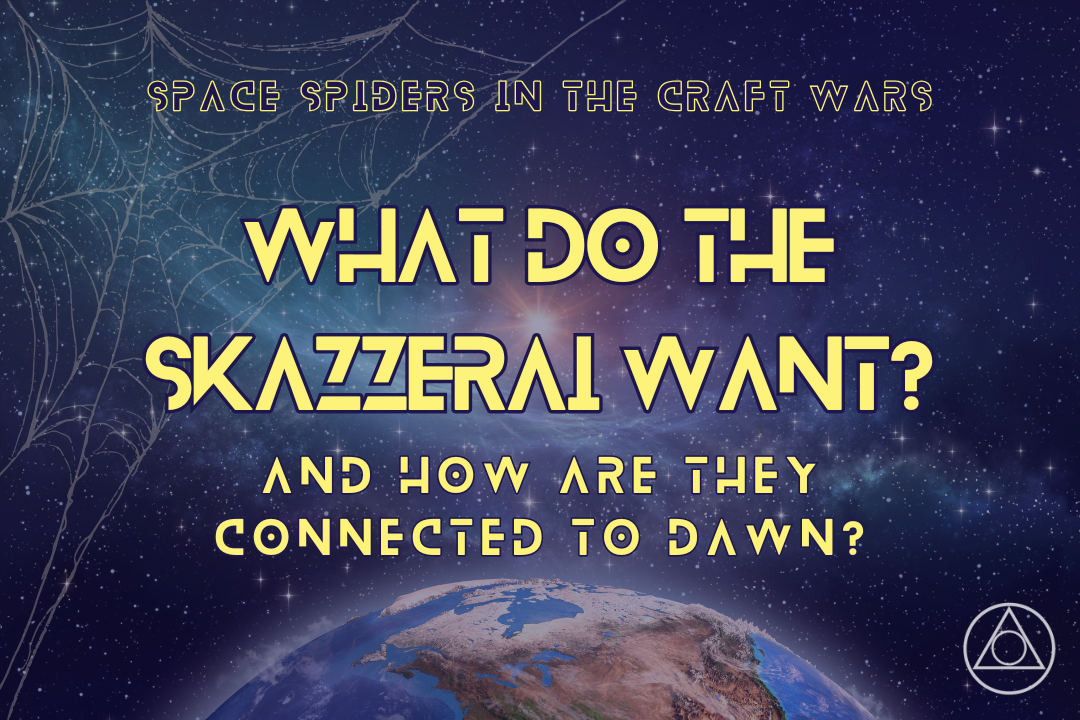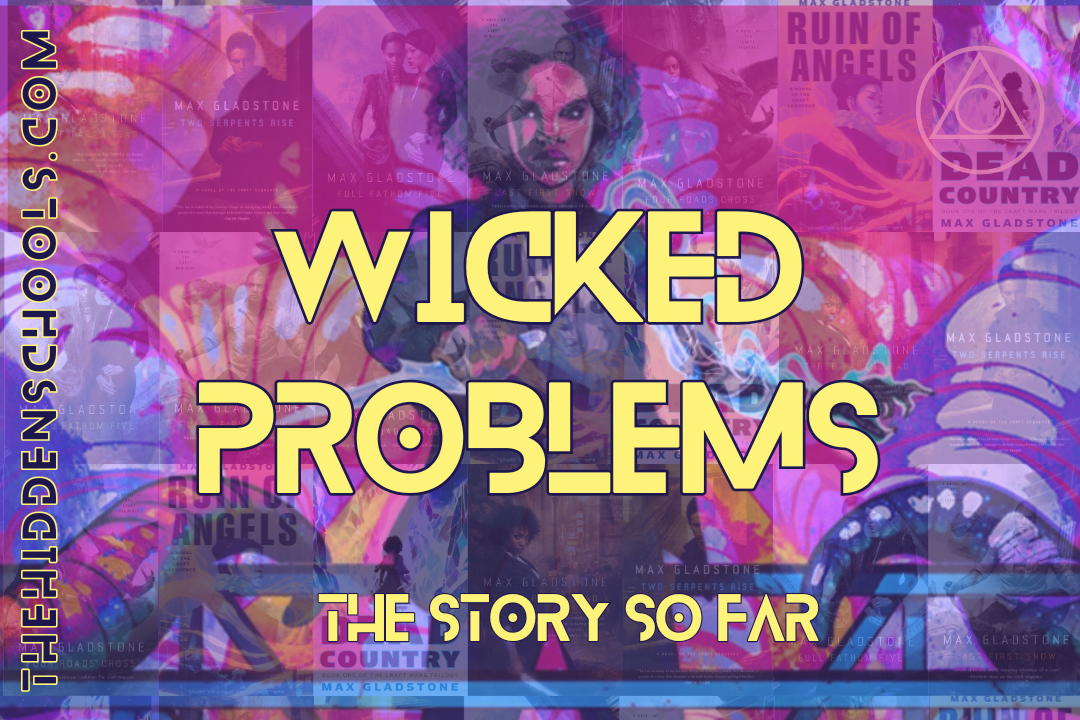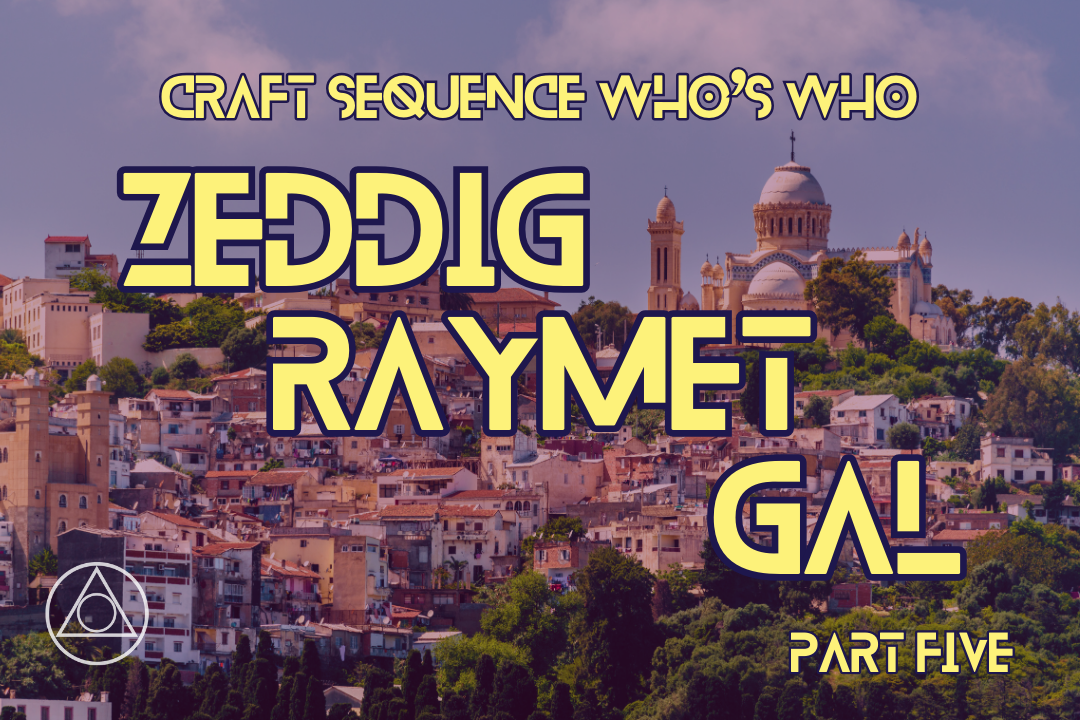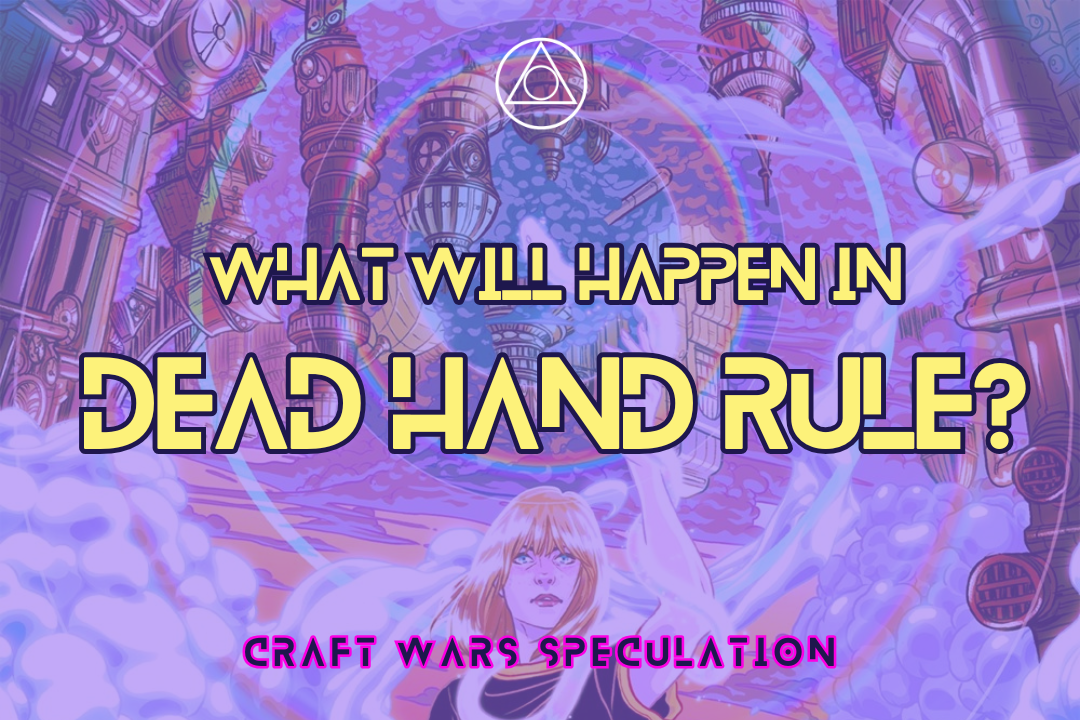The Blue Lady’s Story So Far
Some of this is adapted from other essays, some is brand new. Enjoy!
The newest deity on the scene, the Blue Lady was born in the caldera of Kavekana, found speech through Seril, and freedom through her Prophet Thief Izza. The Blue Lady represents those who have fallen through the cracks of Craft society - but can she stand against the might of the skazzerai?
As we approach the publication of Dead Hand Rule, let’s take a look at the Blue Lady’s story so far.
The Blue Lady before the books
Many years ago, the gods of Kavekana rowed away from the island’s shores, singing war songs and sailing off to glory. One by one, the gods and their priests were killed. Kavekana, like much of the Domain, was for the first time in history godless and unprotected.
Sister islands allowed investment from the remaining powers, becoming modern colonies of the Iskari and their ilk. Others sided with Craftsfolk, becoming tropical extensions of their skyspires.
Kavekana went a different route, because Kavekana had the caldera at the top of the mountain. Kavekana had the home of the gods.
And so the remaining priests of Kavekana turned their attentions to a new industry: offshore banking in the form of human-made idols. Idols looked like gods and acted like them, insofar as their pilgrims’ needs required them to. Wealthy folks from around the world who wanted to avoid sacrificing to gods or getting tied up with modern taxation to Deathless Kings could instead go to Kavekana, have an idol built for their needs, and deposit their soulstuff. They got the grace and protection they wanted, the authorities did not get their hands on anything the pilgrims wanted hidden, and Kavekana had a new industry for a modern age.
But this is a world where belief shapes reality. And in the pool of unreality at the top of Kavekana’ai were dozens, hundreds, thousands, even millions of things shaped like gods, with soulstuff and belief funnelled into them.
As we read in Full Fathom Five, no one idol had more than a hundred believers. But idols were bound to one another, and together they became “a great tangle of power and traded soulstuff, evolving over time” - which is how all gods are born.
And it’s how the Blue Lady was born.
She was not, yet, the Blue Lady. The god that awoke in the pool had no name, no voice, no history.
And then Seril returned.
Seril was thought to be killed at the end of the God Wars, her remains carved up and taken as spoils of war by her murderers. We know the King in Red had one piece, the rights to Alt Coulumb’s skies. Another piece, from an unknown pilgrim, was hidden away on Kavekana.
The newborn god found it, and learned about the world beyond Kavekana’ai. Learned about worshippers, and miracles, and grace. But the god couldn’t do anything, not yet. Not until Seril returned in Alt Coulumb, and regained her voice. Then the god in the pool could speak too.
Not as widely as most gods. Not to as many people. But on the paradise island of Kavekana were street kids, unwanted and forgotten, hiding in plain sight. These kids had nothing but themselves, and in desperation sometimes they would call out to anyone who might listen.
The god in the pool answered.
She came first as the Wind Woman, answering the prayers of Sophie. The Kavekanese priest who built the idol noticed, and went to the Order’s leader. They couldn’t have idols waking up, so they arranged for the Wind Woman to die.
The god behind the idol, however, lived.
It tried on more faces. Red Eagle. The Green Man. The Great Squid. Each time it dispensed grace, and each time the kids’ belief grew greater. Yet, every time it was killed. Some of the idols were too big, too flashy, too noticeable.
And then it took on the form of idol Seven Alpha. Shaped like a woman with horns and wings and backward-pointing legs, teeth sharp, face defiant. She met Izza Jalai, who called her the Blue Lady.
“I was the first to hear her. After they took Sophie I climbed the mountain alone and waited, watched the sky. This was early spring. The Lady stepped out of the stone and sat next to me. We talked. She needed to run. I needed, we needed, someone to hide us. She helped us. Everyone told stories about her, but mine were the best. I took Sophie’s place. I liked the Lady, and she liked me. More than liked, over time. I taught her how to run and hide. Turns out gods don’t know that stuff unless they learn from us: she was like a kid, only bigger. She lasted longer than the rest, maybe because she listened better and learned more.”
She lasted longer than the others, but still the Order found her.
And that’s where Full Fathom Five picks up.
Full Fathom Five
Idol Seven Alpha is scheduled to drown. Trades went wrong, she’s in massive debt, and can’t survive. Her portfolio manager Mara stands by the edge of the pool as her death approaches - when fellow priestess Kai Pohala dives into the pool to save Seven Alpha. Kai believes she can do a minor exchange, float her the soulstuff for the next few days and give Mara a chance to sort out a longer term fix. Kai isn’t aware that this death was planned, that Seven Alpha is the Blue Lady.
She almost succeeds, but is torn away at the last minute, and the Blue Lady dies on schedule.
More or less.
Over the course of the book, Kai gradually works out the history outlined in the first section. She learns that a random poet, Edmond Margot, somehow managed to connect with Seven Alpha, and Seven Alpha distributed grace to him. He turned into a poet prophet before losing his muse when she died. And Kai eventually meets Izza, the Blue Lady’s prophet and priestess.
Meanwhile, the god behind the idols is still in the pool, yet to find a new face.
In the end she doesn’t need one.
“What can I do?”
“Teach her. How to speak. How to be. She can’t make sense of herself—built from too many myths. She tries on masks, and none fit. She needs a storyteller. She needs a prophet. She needs someone to break open the walls of the world. She needs someone to interpret her to herself. She needs a partner.”
“First though,” Izza said, “she needs a thief.”
She is rescued by Izza, using the final divinely inspired writings of the now deceased Edmond Margot, and takes on the mantle of the Blue Lady permanently. She’s fully awake and out in the world, and has Izza to make help her make sense of everything.
Thus Izza becomes the first priestess of the Blue Lady, and the Blue Lady becomes the world’s newest deity.
Ruin of Angels
The myth of the Blue Lady spreads over the next couple of years, taking root in the hearts of the kinds of people who have been left behind by the current system. She’s the goddess of the lost and the forgotten and the unwanted. Her theology is somewhat bloodthirsty, Kai reflects when thinking about how to reform it, but that’s because Her followers have pain in common more than anything else.
Kai and Izza are both Her priestesses now, and they think the Blue Lady is still relatively contained on Kavekana. But now She knows how to sneak and how to run. She has spread out from Kavekana across the world, finding new worshippers everywhere She goes - including Agdel Lex. When Kai ends up there, caught in a complicated web of heists, murder, politics, and tech company nonsense, Izza follows her. The Blue Lady’s top two priestesses are together in a hotbed of revolution.
Izza is shocked to learn that her old friend Isaak is a devotee of the Blue Lady. He tries to convert her, which is quite ironic under the circumstances. She hides the fact that she’s the Prophet Thief, unwilling to allow her only remaining old friend look at her differently. The prayer he recites describes the Lady to a tee: “Blue Lady shelter us who live in shadows. Guide us free of traps and mazes.”
Izza angrily confronts the Blue Lady, who responds only with a poker player’s smile. Of course the goddess of the shadows would find her way around the world to all the shadowy places. Izza should have predicted this. Isaak has a blue stone that represents the Lady and can be used in rituals. Izza herself created it, “A perfect symbol of the miracle of theft, of unearned salvation. The stone disk had a kind of metonymic significance: the stone was Kavekana, the Lady’s birthplace, a rock in the water with a hole bored through.”
Kai and Izza are able to speak to each other long distance via prayers to the Blue Lady. They do this early on in the book before Izza arrives in the city, and during the heist when Kai learns it’s been blown. She prays, Izza hears, and the team get a few seconds of warning before the Wreckers descend. A little later, the Lady also helps her escape from the old Altus facility, sending a burst of images into Izza’s mind so she can lead the team out.
Her eyes glow blue when the Lady works through her. She thinks that she needs to talk to the Lady about that, it’s not exactly subtle for a thief.
While most of the crew are arrested, Izza and Isaak end up in an orphanage rather than a prison because of their young ages. Isaak feels that he hasn’t been a good enough follower of the Blue Lady if She worked through Izza rather than him, and everything gets a bit tense.
Meanwhile Kai is soul searching and praying. She thinks about who the Blue Lady is as a goddess, conveniently letting us know as readers.
“She descended winding down to find at the world’s heart a Lady radiant blue, her saviour and salvation, perfect in her cleverness, a flash of the pads of running feet, a glint of horn and tail like a buck from the kind of woods they did not have on Kavekana—the Lady who chose Izza as her prophet—the Goddess who Izza, prophet, formed.
Kai’s Goddess too.
The Blue Lady was a Goddess of ambush, subversion, and escape. She preached: outrun, outwit, endure.
Kai outran—some. Kai outwitted—occasionally. Kai endured—but in a different way from Izza, less hungry, more obstinate. She was not fast enough. She was too comfortable. ”
Izza is able to break out of her orphanage-prison by telling the Blue Lady’s stories. Because the Lady can always escape, always outwit, always outrun. Isaak is injured in a hospital wing, and tells Izza to leave without him - but this time she won’t run away alone. She gets the Blue Lady to channel healing power through her, even though that isn’t the usual kind of thing they do. She argues that a sickbed is a kind of prison, that healing is an escape, and together they are able to heal Isaak’s injuries.
Though the Lady does want to fix the weird bits of human anatomy that don’t make sense to her.
Izza confesses that she’s the Prophet Thief, and the two friends run out of the orphanage together into Agdel Lex, right in time for the revolution.
Isaak goes to gather the rest of the Lady’s followers while Izza goes to the Temple of All Gods to pray alongside Dr Hasim and Umar, the priests who took her in many years before. Izza asks her Goddess ‘how can we help?’ and the Lady replies that they’ll think of something, she likes to improvise. The battle starts, and monsters from the God Wars rise against them. But together they can fight back. The children of the Lady join Izza. They kneel to her, and join their faith and strength and loyalty with hers.
But, ultimately, the Blue Lady isn’t the goddess of last stands. She runs.
So Izza runs through the city, and the dying gods of the God Wastes chase her.
“The Blue Lady sprinted like a shadow through the trees, and she was the Lady’s prophet. There were no trees here, but Agdel Lex and Alikand and the dead city were forests, after a fashion—different layers of the same forest, and she sprang from canopy to trunk to root and back.
The grey followed her. It wanted her. She tempted and tantalised. All that faith, all that meaning, all that soul, out of reach. The grey had no form—lacked believers save its need, lacked dogma save expedience. She ran? Fine. The grey would make itself run faster.
She sprinted over rooftops in the Wings, darted down mazelike Alikand alleys, guided by the knowledge of the kids she’d left behind in the Temple of All Gods. No need to ask directions. She knew these streets as if born to them. The grey could not touch her. Could not keep pace.
It wanted her, though. All the little godlings bled together as they tried to solve the problem of Izza. The grey saw the Lady, felt the shape of her story, and changed to match her. The snake of godlets became a cascade of footfalls, thousands of Izza echoes, running.”
As the grey mass of dying gods imitates Izza and the Blue Lady, the Blue Lady is able to take them into herself. The God Wastes are no more. They became part of the Blue Lady, giving her new and great power.
The Blue Lady, via Izza, is part of the reconstruction efforts after the revolution is over. We don’t know if Izza herself stayed in Alikand to rebuild the city for all its people, not just the High Families, but we know the Blue Lady has foothold there now.
Craft Wars
The Blue Lady has been weirdly silent in the Craft Wars books so far. Sure, her priestesses aren’t in Dead Country so one wouldn’t expect her to make an appearance. But Kai is a pretty major character in Wicked Problems, yet the only time we see the Blue Lady is when Kai is sneaking through Jax’s yacht early in the book and discovers his room studying the skazzerai.
I expected her to appear in Chartegnon when Kai was running from the Iskari, but Seril was the goddess who intervened then. I loved Seril’s part in that story, but the lack of the Blue Lady felt pretty strange. “Blue Lady” as a phrase is mentioned only three times in the book.
And we haven’t seen Izza for a while. I’m convinced both Izza and the Lady will show up before the end of the series, but I’ve been wrong before.
For now, though, that is the Blue Lady’s story so far.
What do you think? Let me know - and don’t forget you can subscribe to be the first to hear about new articles and fun projects in the pipeline. Like what we do here? Tips welcome on ko-fi to help pay for the site!







